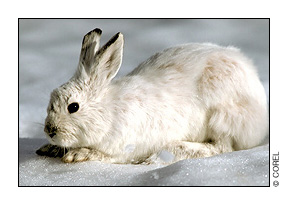Snowshoe hare
Lepus americanus
 Description: Snowshoe hare have large hind feet; both front and hind feet are heavily furred in winter. Their toes spread out like a "snowshoe", enabling them to hop about in deep snow. Both sexes look similar, although females are slightly larger. Snowshoe hare are also called "varying hare" because they molt from a soft brown in summer to mostly white in winter. This color change, stimulated by the change in day length, takes about 10 weeks in the fall and spring. Their droppings or "scat" look like slightly flattened brown pellets.
Description: Snowshoe hare have large hind feet; both front and hind feet are heavily furred in winter. Their toes spread out like a "snowshoe", enabling them to hop about in deep snow. Both sexes look similar, although females are slightly larger. Snowshoe hare are also called "varying hare" because they molt from a soft brown in summer to mostly white in winter. This color change, stimulated by the change in day length, takes about 10 weeks in the fall and spring. Their droppings or "scat" look like slightly flattened brown pellets.
Range and Distribution: Snowshoe hare are found throughout New England, across Canada,, and south to the Appalachian and Rocky Mountains. In New Hampshire they are most abundant in the northern three counties.
Habits and Habitats: In summer hare eat clover, grass, dandelions, berries, and ferns. In winter they shift to twigs, buds, tender bark of shrubs and trees, and stems of bushes and saplings including aspen, alder, spruce, fir, hen-dock, birch, willow, and pine. Lowland spruce-fir forests with dense softwood understories and a mix of hardwoods are ideal habitat.
They may also be found in cut-over areas including clearcuts, blowdowns, and burns. In southern New Hampshire they occupy old fields interspersed with pine juniper, spirea, and hardwoods. Snowshoe hare avoid open areas.
Snowshoe hare are active year-round, mostly at dawn, dusk, or at night. They seek shelter next to a led or large rock, or under tree roots, hollow logs, or fallen trees. This shelter or "form" will be used by the same hare throughout the year. Hare are active within a core area of 5-10 acres; they may range up to 25 acres. Hare populations cycle, with peaks occurring every 9-11 years. They breed from March to August, producing up to four litters per year.
The young, known as "leverets," average three per litter. Unlike rabbits, hare are born fully-furred, with eyes open. They begin hopping at one day old.
Management: Cover is the most important habitat component for hare. They require "base cover" -- the dense softwood cover where they spend the day. Softwood stands with tree heights of 8-15 feet and low lateral visibility (5,000-13,000 stems per acre) is good base cover. "Travel cover" is used by hare to move from their daytime cover to a food source.
Good travel cover includes tree heights of 15-46 feet with a more open understory (1,000-3,000 stems per acre).
Within a 20-acre management unit the following habitat components are recommended: base cover (30%), travel cover (45%), herbaceous food source (10%), and regeneration (15%). Four 1/2-acre openings situated throughout the 20-acre management unit should provide an herbaceous food source.



